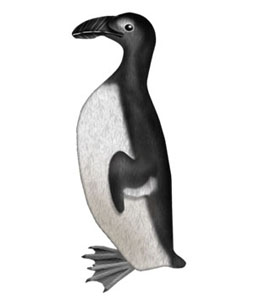Great Auk, Pinguinus impennis
The great auk is one of the few North American birds, such as the passenger pigeon and Carolina parakeet, that have the unfortunate claim to fame of having been hunted to extinction by humans.
The great auk was a large bird, approximately 5 kg in weight and 70 cm in length – about the size of a goose. It was similar in appearance to other alcids, with black upper parts highlighted by a white patch over the eye, white underparts and a sharp, heavy bill. It was unique, however, in being flightless. It was originally known as the “garefowl” or “penguin”, which may be derived from a word meaning “pin-winged”. Although the great auk bore many resemblances to the penguins of the Southern Hemisphere, it was not related to them. It was the first bird to be called “penguin”, but the word was later transferred to the southern birds that now hold sole claim to the name.
The great auk nested in colonies on ocean shores and small islands, although its flightless nature prevented it from nesting on high cliffs. Its principal breeding areas were off the coast of Newfoundland, in Iceland and in Scandinavia, but it also nested in Greenland, and occurred in the Davis Strait although it is not known whether it bred there. Like other alcids, it was an excellent swimmer, diving from the surface to pursue fish. Owing to its size, it could prey on larger fish than its relatives, the razorbills and murres.
This species was found in Canadian waters in the early 1500s and was so common around the Grand Banks that navigators used the presence of auks to indicate the exact position of the Banks. Crews of fishermen and sailors alike discovered that it was easy to catch and, because of its size, it supplied a large amount of food. Boats would stop at islands to allow sailors to herd the auks along a plank to the decks, where they killed the birds, eating some immediately and preserving others in salt to use later. The French explorer Jacques Cartier spoke of one such occasion in 1534:
“… some of these birds were as large as geese, being black and white with a beak like a crow’s. […] And these birds are so fat it is marvellous… In less than halfe an houre we filled two boats full of them, as if they had been stones, so that besides them that we did eat fresh, every ship did powder and salt five or six barrels full of them…”
Sometimes groups of auks were kept alive inside the boats, to serve as fresh meat when none was available. Some sailors also processed the birds to produce “fish oil,” and auk feathers were valuable for many uses. Because of its inability to fly and its lack of fear of humans, the great auk was defenceless and could be killed without even a gun.
Although the great auk was hunted regularly from the early 16th century, the effects of this slaughter were not noticed until the late 18th century – and even then, no serious efforts were made to protect the bird. In 1775 the government of Nova Scotia asked the parliament of Great Britain to ban the killing of auks. This was done, and anyone caught killing auks for feathers, or taking their eggs, was beaten in public, but fishermen were still allowed to use the birds as bait. Only one other man expressed concern over the possible fate of the great auk:
“A boat came in from Funk Island laden with birds, chiefly penguins … But it has been customary of late years, for several crews of men to live all summer on that island, for the sole purpose of killing birds for the sake of their feathers, the destruction which they have made is incredible. If a stop is not soon put to that practice, the whole breed will be diminished to almost nothing, particularly the penguins.”
George Cartwright, 5 July 1785
While auks were being killed in Canada to feed fishing crews, major colonies in Iceland were also regularly raided for meat, eggs and feathers for mattresses. The Icelanders harvested birds in rotation, leaving colonies to recover their numbers between collecting expeditions, but eventually the hunting pressure became too great and European colonies also experienced drastic population declines. Only then, when the birds were extremely rare on both sides of the Atlantic, did the world begin to recognize the plight of the great auk.
The supreme irony in the fate of this great flightless bird of the North Atlantic is the reaction of humans to its decline. Instead of protecting the bird and preventing its extinction, museums and collectors all over Europe clamoured for specimens of the vanishing species. Expeditions went out to capture skins and eggs, which were then sold at high prices. In 1830, a great auk skin was sold for the equivalent of $16, at a time when the average yearly wage for a skilled worker was just over $18.
The final few events in the history of the great auk took place in the early 19th century. In 1813, Britain and Norway were blockaded during the Napoleonic wars, and ships anxious to obtain provisions harvested birds from colonies in Iceland, dealing the auk another serious blow. Another colony in Iceland was destroyed when a volcano erupted, submerging it below the ocean. Few auks were seen anywhere after the 1830s, but during a severe storm in 1844, one was found on the Hebrides Islands off Scotland. Local islanders blamed the storm on the bird, tried it by jury, and stoned it to death – for witchcraft. This was one of the last auks. On June 3rd, 1844, three men set out for the Island of Eldey, off Iceland, at the orders of a collector who wanted auk specimens. There they found two auks at a nest containing one egg, and quickly killed all three, which were later sold. The great auk was never seen alive again.
Although the last great auk was killed in 1844, many scientists were unaware of its extinction until much later. Once the world realized it had gone, however, the trade in auk eggs and skins boomed, and in 1898, one skin and egg were sold for the equivalent of $1400. This amounted to twelve times the annual wage of a skilled worker – more than enough money, in 1844, to have hired an armed guard to protect a colony of auks for a decade!

